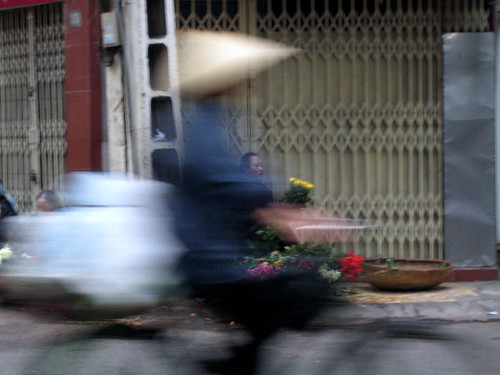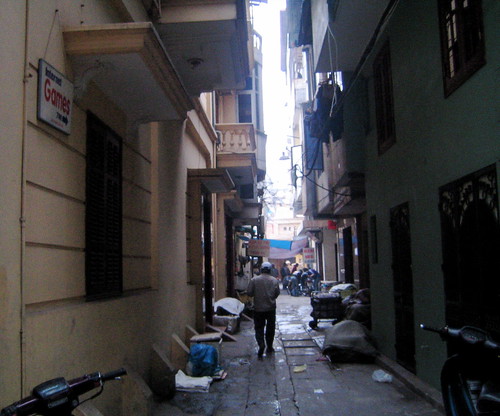I’ve had a wicked case of the flu the past couple of days, and an important paper deadline in less than two weeks. I was trying to work, but frankly I’m feeling too weak and feverish to accomplish anything other than watching about a dozen episodes of House, MD, finish up some trivial work for my project with the Vancouver Art Gallery, and write a little bit about Vietnam.
Laos and Vietnam have so much in common — French colonialism, American bombing, decades of communism — that it’s actually quite shocking how different they are. Laos is pastoral and friendly; Vietnam is crowded, dirty, noisy and unwelcoming. It’s like Vietnam is trying to compress an industrial revolution that took two hundred years in Europe into a couple of decades. Everywhere you look, there’s signs of rapid industrialization — construction projects, insane traffic, and choking pollution.
Combined with this is a culture that treats foreigners like walking ATMs — we only spent a couple of days in Hanoi, but by the time we left, we had been asked to buy hundreds of items and taxi rides. And if you ever do inquire about buying anything, you get slapped with foreigner pricing. It seems common for vendors to charge foreigners five or ten times what they charge locals. And it’s official policy, too — the foreigner pricing on public buses is so high, most travelers take private buses run by tour companies instead, and by government mandate “foreign guests” pay triple the accommodation rates Vietnamese do. Not to mention, scams targeting foreigners are, apparently, rife. Now, I understand that to the typical Vietnamese, even a budget backpacker like myself is fabulously wealthy, but it is pretty disheartening to continually face this “money barrier” between you and the locals, especially after they way we were treated in (much poorer) Laos and (much richer) Thailand.
But I digress. Back to Hanoi, the most striking thing is the traffic. Little scooter-motorcycles account for probably 90% of the traffic, and you regularly see huge boxes and entire families piled onto them. Our cab into the city flew through them like a hand through a cloud of gnats. Traffic lights in Hanoi are infrequent, and even less frequently obeyed. We arrived on New Years Eve, and the scene in Old Hanoi was chaos. Like most old cities, the streets are both narrow and crooked. The moto traffic was so thick, it resembled nothing so much as hoses firing streams of motos down the streets, flying past each other at the intersections in four different directions. And honking. Gad, is there a lot of honking. Though in Vietnam honking is used differently than in the west. In Vietnam, honking means “I’m going to fly past you as fast as I can, as close as I possibly can, so don’t you dare do anything unexpected”. You hear this a lot in Old Hanoi, because the sidewalks are so full of vendors, parked motos and families cooking dinner that all foot traffic shuffles nervously along single-file in the two feet of space between the gutter and the moto traffic. Crossing the street is a matter of making sure you’re as visible as possible, stepping out into the traffic and praying, while buffeted by the breeze of passing motos.
Old Hanoi actually looks kind of cool. Lots of bars and restaurants and historical monuments. But being constantly hassled to buy things and the noise and traffic and pollution made the whole experience unpleasant. By the time we left, I was acclimating to the whole scene, but I would have had to be there a couple more days before I would have begun to enjoy it.

Janelle, on the other hand, seems to have liked it whole lot

